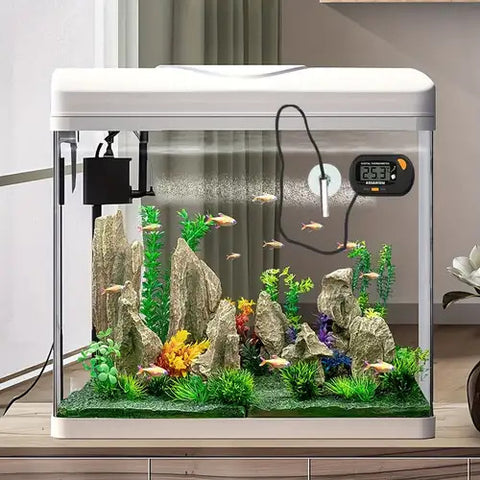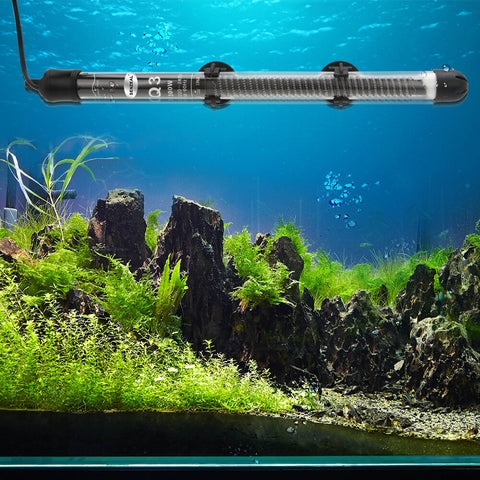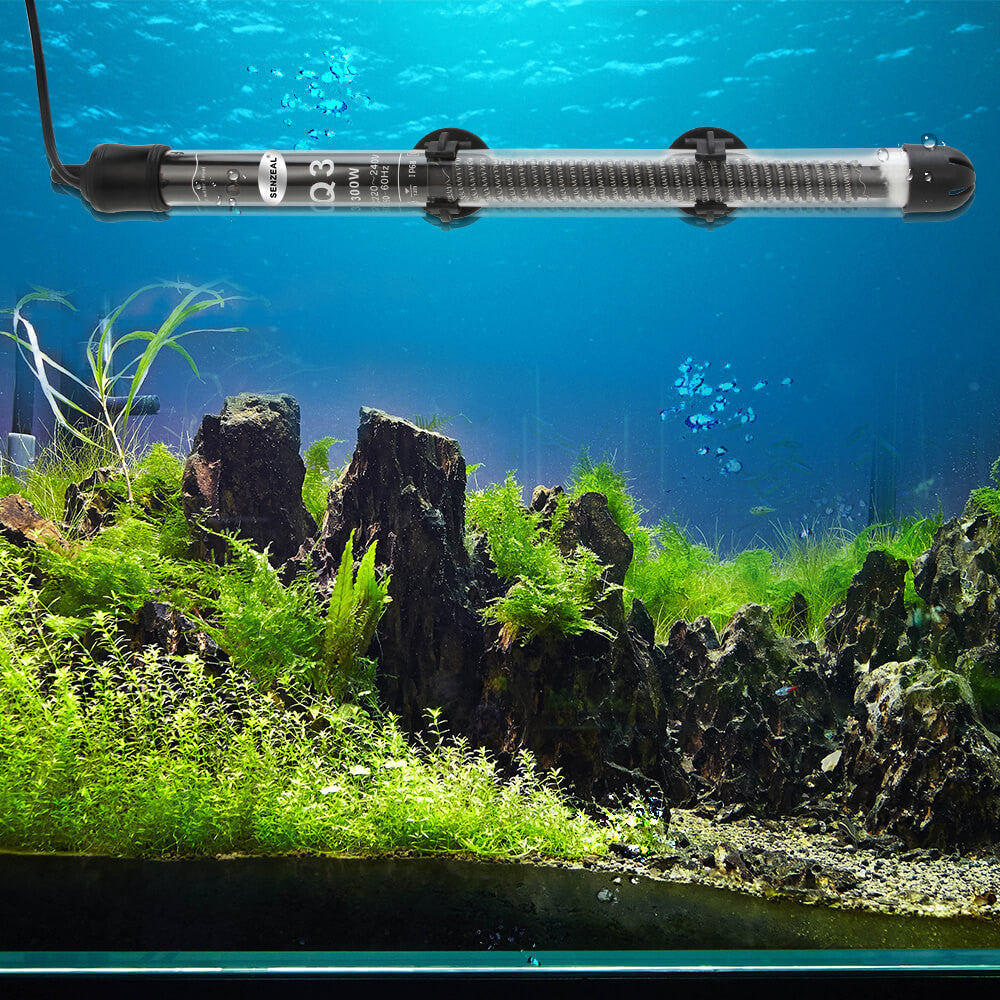Table of Contents
How to choose the right Aquarium Heater for your fish tank?
Aquarium heater is not alien to the fishkeeping community, and even beginners may have heard of it not just once, a device used to warm the water temperature in aquariums.
Indeed, many aquariums need heater(s). However, not all the heaters suit every aquarium. In order to choose the right one, you need to understand a few basic things before heading to any store nearby.

Does my fish tank need an aquarium heater?
The answer is it depends: depending on the type of your fish, depending on the size of your tank, depending on the climate where you live, and even depending on the ‘tricks’ you may use in case your fish tank does need an aquarium heater, but you are not willing to equip one.
Fish are cold-blooded creatures. They almost rely on the surrounding temperature to sustain their body temperature. That makes the maintenance of the appropriate warmth for your tank is no less important. Without an aquarium heater, it will take you a lot of time and effort to get things in order.
However, in fact, there are some fish that do not actually need heaters. Coldwater species are an example. They are hardy and able to live in a wide range of cooler water and even adapt to frequent fluctuations in water temperature. If you really don’t want to spend budget on the device, you could consider keeping them (ex. hillstream loach, guppy, koi guppy, pearl danio, etc.)
Another way to maintain proper aquarium conditions without a heater is using “tricks”. They are shared by most skilled aquarists like taking advantage of the heat produced by lighting systems, or placing your fish tank near warm areas, etc. These tricks are somehow practical but take much of your precautions before implementation. Otherwise, they do more harm than good.
How to choose the right aquarium heater for my fish tank?
The quick answer is to ask the fish store owner(s). However, we believe you may want to find it by yourself first before coming to their advice.
There are many aquarium heaters available in the market with a variety in brand, shape, type (e.g., submersible, inline heater, substrate heater, etc.) and size (e.g., 50W, 150W, 300W, etc.). Yet, the key factors which will affect your decision lies in the type and size of a heater.
Type
Submersible heater
Submersible heaters, like their name, are those completely submerged in the tank. Their shape is quite simple, commonly a long stick (where the heat is produced) with one to two suction cup(s). Submersible heaters can be placed at any position in your fish tank but mostly near the filter output. As the flows generated from it will help spread the warmth to the rest of the tank.
This type of heater is widely used by many aquarists because it is relatively cheap, convenient and easy to replace when broken down. Submersible heater will also be our focus in this article.
Inline heater
Inline heater is an external heating device that warms the aquarium water while it flows through the plumbing system. The common type of this heater is built-in canister filter. To operate, it requires a pump to move the water through and when being released back to the fish tank, the water then reaches the preset temperature.
Inline heaters are preferable mainly for aesthetic purposes. Because it is placed outside, aquascapers don’t have to worry about how to conceal it hence, they are free to create their own desired aquariums. Despite that, this type of heater may cost quite a large sum of money and be prone to leakage.
Substrate heater
Substrate heater is less popular compared to its other “friends”. It is a kind of cables covered with insulator and buried in aquarium substrates. The cables are heating elements which become warm while being on.
Like inline heaters, substrate heaters serve the aesthetic purposes as they are hidden from the view. However, its big flaw makes it less attractive as you have to disturb your whole aquascape when you want to fix or replace it.
Size
Finding the right heating size for your tank is as important as deciding on the type of heater. Water temperature is affected by many factors, among others, the size of your fish tank, actual water volume contained therein, and your average room temperature.
To identify it, first of all, you have to find out the heating capacity required for your aquarium. Do the simple math by subtracting the average temperature of the room from the target temperature for the aquarium water. There, you’ve got a glimpse of it.
Next, apply the rule of 5 watts per gallon of actual water volume (the net volume of water after accounting for the displacement of rocks, live aquatic plants and substrate) and refer to our recommended heater size chart below to determine your heater size in need.
|
Tank size |
Heater size (to raise the temperature by 10 degrees) |
Heater size (to raise the temperature more than 10 degrees) |
|
5 gallons/ 20L |
25W |
50W |
|
10 gallons/ 40L |
50W |
100W |
|
20 gallons/ 75L |
100W |
150W |
|
29 gallons/ 110L |
150W |
200W (or 2 heaters x 100W) |
|
40 gallons/ 150L |
200W (or 2 heaters x 100W) |
300W (or 2 heaters x 150W) |
|
55 gallons/ 208L |
300W (or 2 heaters x 150W) |
400W (or 2 heaters x 200W) |
|
75 gallons/ 300L |
400W (or 2 heaters x 200W) |
600W (or 2 heaters x 300W) |
Note: Please note that this chart should be used as a general guide. As the water temperature will be affected by many other factors in addition to the aquarium heater. For example, where you place your fish tank (near heat sources or not), whether your tank is covered with a lid, climate where you live, and so on.
With large fish tanks, we suggest using more than one heater so as to ensure the temperature does not fluctuate. In this case, the total heating capacity of all the units together should add up to the required wattage (see the example in the chart above).
Now, read to this line, you can confidently visit any pet store to pick up the heater appropriate to your aquarium. However, if you want to learn more about tips and notes while using your heater, keep scrolling down.
FAQs
Do you leave the aquarium heater on all the time?
Yes. Most of the recent aquarium heaters have an internal thermostat which will turn off the heat when it reaches a specific temperature (to be sure, you should further check the description on its label). Thus, you don’t need to worry about overheating issues. When the water is cooler than the desired temperature, the heater then automatically activates.
Where should I put my aquarium heater?
Like we mentioned above, the ideal location for your aquarium heater is near the filter output. Mount it either horizontally or vertically or even at a 45 degree angle as you’re pleased, and make sure you submerge it completely while turning it on (as it may burn out if being exposed to dry air) for its best operation.

Image caption: The water at the bottom of the fish tank is normally cooler than the surface, hence you may consider putting it near the bottom.
If you use more than one heater, install them at opposite ends of the aquarium to ensure even heating. This not only puts less strain on the heaters but also controls the water temperature not plummeting too much if one is damaged.
When placing heater, make sure the heater’s glass isn’t touching the glass walls of the tank, or gravel, or an ornamental item inside. As again, it would cause the glass to break, potentially killing your fish through electrocution.
How to acclimate my tank heater?
When you first install a submersible heater, let it sit in the water for 30 minutes to 1 hour before plugging it in. This will help your heater acclimate to the aquarium water’s temperature hence, prevent the heater glass getting shocked and breaking due to the difference in temperature.
That also means the similar process should be applied when you unplug your heater for water change or alike. The heater elements need time to cool down. Otherwise, it shortens the lifespan of your heater, or even worse the heater glass may break and contaminate your tank.
Do I need a separate thermometer while I already have an aquarium heater?
It is not necessary but we recommend you check the water temperature with a thermometer regularly. This ensures the temperature is maintained at the desired rate. Move the thermometer around the tank to get the precise result.



























